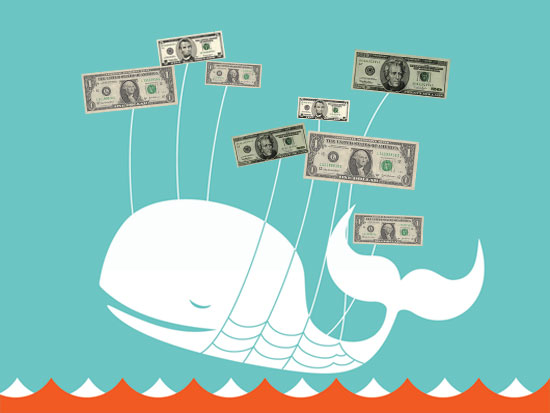Dan Ziman says yes, and lays out his case. A couple of years ago I said I would pay for Twitter (and Dan’s $30/year is in my budget), but I haven’t gotten any feeling that paid personal accounts are part of Twitter’s model. It brings us back to the idea of “free” (yes, I read Chris Anderson’s book), and what is the friction point after which you lose all your customers? As Dan acknowledges, Twitter is in danger of losing to a free competitor if they start charging, so it seems that this idea remains a loser- not that it answers the “How will Twitter make money” question.
Beth Harte’s Monstrous Transparency Experiment
OK, I kid with the “monstrous.” But during this week’s “PR2.0 chat” on Twitter, Beth had someone “ghost-Tweet” for her during the proceedings– without telling anyone until after. she did so to raise the topic of transparency and honest in online communications. This is something that we in PR tackle every day, and constantly have to reinforce the line. “Ghost-blogging,” by the way, is not a black-and-white no-no in my book, but neither is it something I do readily. If you are in PR and marketing, have you been asked by clients or bosses to do something that crosses an ethical line, or falls into the gray area nearby? I bet you have.
Beth played a mean trick on a group of people she knew could take it, and I hope these discussions continue. We don’t have to agree, but silence on the issue would be troubling.
WebEx Blogger Doesn’t Disclose (Enough)?
After all this transparency talk comes this case, via John Cass, of a blogger, David Chao, who happened to be employed by WebEx posting a bad review of a competitor, DimDim (whose Marketing lead, Steve Chazin, is a former client and all-around good guy, by the way). The blogger did not mention in the post that he is a Cisco/WebEx employee, but a quick click to his “About” page revealed the fact. Was that enough? Chao may have honestly thought so– but next, a DimDim employee apparently left a comment that was never approved and published. That’s a lot harder to defend. John supposed this is a “slight oversight,” but I’m not sure either way.
Now, there are Cisco disclosures all over the site, and in the post itself, along with an update with corrections from Steve Chazin. End result? Better. Too long a road to get there? Probably? Lessons leaned? I guess so.
Sports Figures Continue To State the Obvious
Truly scrumptious. “Texas Tech Football Coach Calls Twitter Users Narcissists.” Of course, there is a point in that too many examples exist of athletes Tweeting before they think (as mentioned in the linked Mashable article) clash with if-you-fear-it-ban-it team officials. The irresistible farce meets the immovable dips**t, I guess.
Hey, I’m just taking things one Tweet at a time, giving it 140%.
Washington Post Social Media Guidelines: What’s the Big Deal?
There has been some handwringing over the recently leaked social media guidelines from the Washington Post. Steven Baker of BusinessWeek, for one, seemed troubled by the seeming restrictions on social media use. The following paragraph is probably one of the troublesome ones:
Post journalists must refrain from writing, tweeting or posting anything—including photographs or video—that could be perceived as reflecting political, racial, sexist, religious or other bias or favoritism that could be used to tarnish our journalistic credibility. This same caution should be used when joining, following or friending any person or organization online. Post journalists should not be involved in any social networks related to advocacy or a special interest regarding topics they cover, unless specifically permitted by a supervising editor for reporting and so long as other standards of transparency are maintained while doing any such reporting.
I understand that a tight enforcement would be a drag, and that personal is personal, but what I see int he guidelines as a whole is a lot of common sense in how to conduct the irretrievable commingling of personal and corporate brand. I would certainly think twice before aligning myself with something that would directly contradict the values of my employer- but then, I’m not as worried about political ties and potential bias perception– AS worried. Is it necessary to spell out personal usage rules in such detail in a corporate policy? Maybe not- but for some reason, I’m not quite so offended by them

 Pay for Twitter?
Pay for Twitter?
Stupid Transparency Trick??? Ouch, Doug! ;-)
Hmmm, I didn’t think it was stupid (well, of course, right? It was my idea…).
But you know what? I think it’s landed me in your camp. While far from a scientific test it opened my eyes to the fact that people who I assumed would say “Beth?? Is this really you?” never did. What’s that say about always being authentic, transparent, etc.?
Perhaps it’s just about being fair in delivering the information/relationships people are looking for.
Have a great weekend!
Beth
Doug,
I’m republishing some of the content I posted on Beth’s blog in her transparency post here, just because conversations become disjointed, but also because I think I need to talk about Beth’s experiment in light of the WebEx blogger incident.
I think this question of authenticity is all about money. Basically a few years ago few companies used social media, and there was not much of a market for generating content via social media. Those people who started using social media developed the community, and used many of the ethics from the field of journalism. Authenticity became the order of the day.
The genesis of authenticity is basically if I write content, where people have the ability to write back to me, I’d better be prepared to answer otherwise I may be caught out as a fraud.
As more and more people started using social media, and more companies jumped in to start using social media for promotion, the market for developing content in social media grew.
Customers for social media content were either unused to developing the content, did not have time or assumed that as they had once paid for content in traditional media from other authors to represent them, it was completely okay to do so for social media content.
The market for ghost content grew, and though most writers would probably prefer authenticity, it actually helps to have more bylines; ghost content writing does pays the bills.
As the number of customers and vendors of ghost content has grown over the years, the voices for authenticity though still vocal have grown less significant.
I think the debate is really about what the ROI of authenticity. If the community believes ghost social media content is a cost effective way to promote a company, the community will continue to ghost write social media content. If the community believes writing such content doesn’t get the sort of ROI they are looking for it will diminish. I think the level of ghost writing in social media is more dependent upon the market, and that market is dependent upon the law, social rules in the community, and how the community responds to revelations of ghost writing. If the community criticizes social media ghost writing and the consequences of ghost writing social media content is harmful to a brand there will be less of it. If not, I think the practice will grow.
I look at the market and the changes that have happened over the last few years, and wonder if the ideas contained in the cluetrain are dead, or were ever valuable. The central idea people are online and they are talking together is still true. The web is not one large community but a series of different companies. I read in on Beth’s blog in the comment thread that many people suggest ghost writing is okay, and it’s been done in PR and communications for a long time. But I wonder if those people are living in the PR echo chamber, or maybe the ghost writing echo chamber? And if you may be setting yourself up for a fall when you write for a community that takes a dim view about writing in an inauthentic way.
Here’s where Beth’s experiment and the WebEx incident intersect. I firmly believe that social media communities can police themselves; it’s up to the members of the marketing, PR and social media communities to call out to people who are uses practices that don’t seem fair or credible. A lot of writers in the past have panned bloggers who made mistakes. In this case I believe the community provided constructive criticism and attempted to help the WebEx blogger in learning some of the rules of the community, and what works in communicating with people. As a result of these exchanges things did change, and it seems the blogger has gained from that experience.
On the question of transparency and ghost blogging, just because the tone in the echo chamber has changed does not mean that we should not continue to get involved. To me the lesson is that’s its still possible to convince the community and individuals that their communications strategy should be one of authenticity and engagement.
Beth– I wouldn’t want people to not care if it’s you, but I would want people to think that this is your voice, even if someone else types– and even helps craft- the words.
John– Nice point about authenticity and money. I think that is why spam still exists; because it is working for people, despite being unethical. The only difference is I won’t cover ghosting with the unethical blanket, depending on how it is done.
I also believe that the self-correcting nature of Web communities takes over– but that means we need to take active roles in calling out ba actions. It also means audience needs to be discerning– what if they read before the “self-correcting” happens? It’s dangerous, and people in every step of the chain have responsibility. What I don;t believe in is the power of the community to self-correct 100% of the time- what happens when they don’t?
Twitter Comment
RT @KellyeCrane: RT @DougH: Social Media: Pay for Twitter, Stupid Transparency Tricks, WaPo Social Media Guidelines [link to post]
– Posted using Chat Catcher
Twitter Comment
Godd stuff. RT @DougH: Social Media Top 5: Pay for Twitter, Stupid Transparency Tricks, WaPo Social Media Guidelines [link to post]
– Posted using Chat Catcher
Twitter Comment
RT @DougH: Social Media Top 5: Pay for Twitter, Stupid Transparency Tricks, WaPo Social Media Guidelines [link to post]
– Posted using Chat Catcher